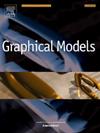Goal-oriented 3D pattern adjustment with machine learning
IF 2.2
4区 计算机科学
Q2 COMPUTER SCIENCE, SOFTWARE ENGINEERING
引用次数: 0
Abstract
Fit and sizing of clothing are fundamental problems in the field of garment design, manufacture, and retail. Here we propose new computational methods for adjusting the fit of clothing on realistic models of the human body by interactively modifying desired fit attributes. Clothing fit represents the relationship between the body and the garment, and can be quantified using physical fit attributes such as ease and pressure on the body. However, the relationship between pattern geometry and such fit attributes is notoriously complex and nonlinear, requiring deep pattern making expertise to adjust patterns to achieve fit goals. Such attributes can be computed by physically based simulations, using soft avatars. Here we propose a method to learn the relationship between the fit attributes and the space of 2D pattern edits. We demonstrate our method via interactive tools that directly edit fit attributes in 3D and instantaneously predict the corresponding pattern adjustments. The approach has been tested with a range of garment types, and validated by comparing with physical prototypes. Our method introduces an alternative way to directly express fit adjustment goals, making pattern adjustment more broadly accessible. As an additional benefit, the proposed approach allows pattern adjustments to be systematized, enabling better communication and audit of decisions.

目标导向的3D模式调整与机器学习
服装的合身和尺寸是服装设计、制造和零售领域的基本问题。在这里,我们提出了一种新的计算方法,通过交互修改期望的合身属性来调整人体逼真模型上的服装合身度。服装合身代表了身体和服装之间的关系,可以用身体的舒适度和压力等物理合身属性来量化。然而,模式几何与这些拟合属性之间的关系是出了名的复杂和非线性,需要深厚的模式制作专业知识来调整模式以达到拟合目标。这些属性可以通过基于物理的模拟计算,使用软化身。本文提出了一种学习二维图形编辑的拟合属性与空间关系的方法。我们通过交互式工具演示了我们的方法,该工具可以直接在3D中编辑适合属性并立即预测相应的模式调整。该方法已经在一系列服装类型上进行了测试,并通过与实物原型的比较进行了验证。我们的方法引入了一种直接表达拟合调整目标的替代方法,使模式调整更容易实现。作为一个额外的好处,所建议的方法允许将模式调整系统化,从而能够更好地沟通和审计决策。
本文章由计算机程序翻译,如有差异,请以英文原文为准。
求助全文
约1分钟内获得全文
求助全文
来源期刊

Graphical Models
工程技术-计算机:软件工程
CiteScore
3.60
自引率
5.90%
发文量
15
审稿时长
47 days
期刊介绍:
Graphical Models is recognized internationally as a highly rated, top tier journal and is focused on the creation, geometric processing, animation, and visualization of graphical models and on their applications in engineering, science, culture, and entertainment. GMOD provides its readers with thoroughly reviewed and carefully selected papers that disseminate exciting innovations, that teach rigorous theoretical foundations, that propose robust and efficient solutions, or that describe ambitious systems or applications in a variety of topics.
We invite papers in five categories: research (contributions of novel theoretical or practical approaches or solutions), survey (opinionated views of the state-of-the-art and challenges in a specific topic), system (the architecture and implementation details of an innovative architecture for a complete system that supports model/animation design, acquisition, analysis, visualization?), application (description of a novel application of know techniques and evaluation of its impact), or lecture (an elegant and inspiring perspective on previously published results that clarifies them and teaches them in a new way).
GMOD offers its authors an accelerated review, feedback from experts in the field, immediate online publication of accepted papers, no restriction on color and length (when justified by the content) in the online version, and a broad promotion of published papers. A prestigious group of editors selected from among the premier international researchers in their fields oversees the review process.
 求助内容:
求助内容: 应助结果提醒方式:
应助结果提醒方式:


